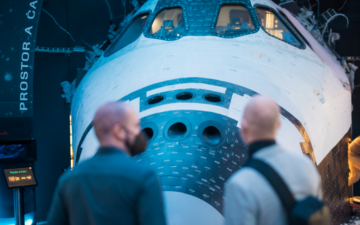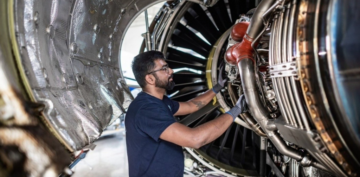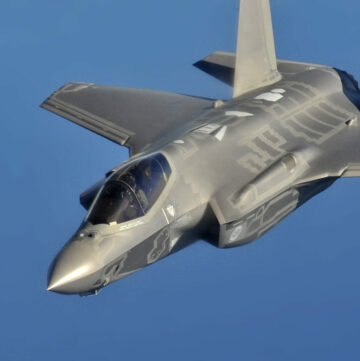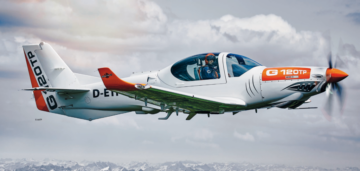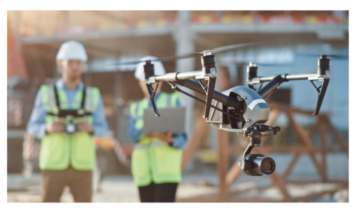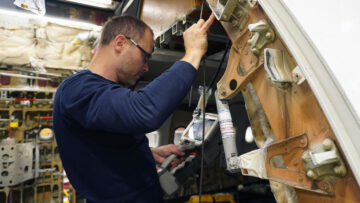The aviation industry is facing an unprecedented challenge in balancing its environmental impact with the increasing demand for air travel. Avio Aero, a subsidiary of GE Aerospace, is leading the charge with the launch of its innovative AMBER project. In this exclusive interview, we’ll sit down with Jesus Lopez Ruiz, AMBER System Leader at Avio Aero, to learn about the program’s goals and the impact it will have on the future of commercial aviation. With the support of the Clean Aviation Joint Undertaking of the European Commission, this visionary project brings together 21 leading organizations to explore the integration of hybrid-electric components, fuel cells, and advanced technology gas turbine systems. Get ready to explore the world of hybrid-electric propulsion and how AMBER is set to revolutionize the skies and bring a greener tomorrow for the aviation industry.

The AMBER program is a ground-breaking effort to develop hybrid-electric propulsion technologies for commercial aviation.
What is the purpose of Avio Aero’s new technology demonstration program?
The purpose of the program is to advance the development of hybrid-electric propulsion technologies for commercial aviation and support European efforts to reduce CO2 emissions by making air transport more fuel-efficient. The AMBER demonstrator will study the integration of components, including a motor/generator, power converters, and power transmission systems with fuel cells, using Avio Aero’s advanced Catalyst turboprop engine.
How much funding has the Clean Aviation Joint Undertaking of the European Commission awarded to the consortium led by Avio Aero for the AMBER demonstrator?
The Clean Aviation Joint Undertaking of the European Union has awarded approximately €34 million over four years to the consortium led by Avio Aero, which consists of 21 members, including GE Aerospace European sites, Leonardo, H2FLY, and various universities and research centers.
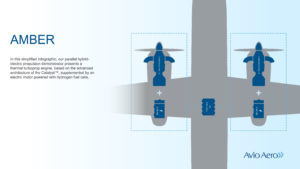
The program is being funded by the Clean Aviation Joint Undertaking of the European Commission and brings together a consortium of 21 leading organizations.
What is the goal of the AMBER demonstrator program?
The goal of the program is to mature, integrate, and validate the key technologies needed for a megawatt-class hybrid-electric propulsion system powered by hydrogen fuel cells. The program aims to establish the performance and readiness of the technologies and propulsion system configuration to support the EU’s SRIA objectives for aviation decarbonization.
What components will the AMBER demonstrator study the integration of?
The AMBER demonstrator will study the integration of hybrid-electric components, including a motor/generator, power converters, power transmission systems, and fuel cells, using Avio Aero’s advanced Catalyst turboprop engine. The entire mechanical and electrical network of the propulsion system will be studied and tested.
How will the hybrid-electric propulsion system be powered in the AMBER demonstrator?
The hybrid architecture of the AMBER demonstration program combines electrical components, hydrogen fuel cells, and advanced technology gas turbine systems to increase efficiency and minimize emissions from the propulsion system. For the demonstrations in the AMBER program, the Catalyst gas turbine will use Sustainable Aviation Fuel (SAF), and the fuel cell that powers the electrical machine will run on hydrogen.
What are the potential benefits of hybrid electric propulsion technologies for commercial aviation?
Hybrid electric propulsion technologies can improve engine performance, reduce fuel usage and emissions. The ability to downsize the gas turbine relative to that required by the aircraft in a conventional, non-hybrid configuration can result in significant gains. The electrification technologies being developed by Avio Aero and GE Aerospace are compatible with alternative fuels like SAF and hydrogen and with advanced engine architectures like open fan. The Catalyst engine can operate on approved SAF, which has lower lifecycle CO2 emissions than petroleum-based fuel.
What alternative fuels are compatible with the hybrid electric technologies being developed by Avio Aero and GE Aerospace?
The alternative fuels compatible with the hybrid electric technologies being developed are Sustainable Aviation Fuel (SAF) and hydrogen.
Who is a member of the consortium led by Avio Aero?
The consortium led by Avio Aero consists of 21 partners across Europe, including Avio Aero’s European technology development network of universities and R&D centers, and GE Aerospace sites in various European countries.
Who is responsible for the build-up of the MW fuel cell system as part of the powertrain validation and testing in the AMBER project?
The German-based company H2FLY is responsible for developing the technologies for the fuel cells that will be integrated into the engine architecture. H2FLY is a worldwide leader in zero-emission propulsion systems powered by hydrogen.
How does the AMBER project fit into Clean Aviation’s ambitions for climate-neutral aviation?
The Clean Aviation partnership with industry aims to speed up the development of key technologies, such as electrification, to achieve its goals for climate-neutral aviation and support the European Union’s efforts towards carbon neutrality, as outlined in the Strategic Research and Innovation Agenda (SRIA). AMBER is one of several Clean Aviation projects that Avio Aero is involved in, and it has recently received funding. The HYDEA project, which is coordinated by Avio Aero, will work on developing a hydrogen combustion engine and will involve collaboration with Safran Aircraft Engines, Airbus, and other European companies, universities, and research centers. Another Clean Aviation project called OFELIA, coordinated by Safran Aircraft Engines, aims to demonstrate the open fan architecture in flight tests later this decade in collaboration with Airbus, with Avio Aero as a key partner.
What are the specific technologies being tested and developed within the AMBER demonstrator program?
The AMBER demonstrator program will conduct end-to-end demonstrations that will involve electrical components, hydrogen fuel cells, and advanced technology gas turbine systems. The program will also focus on the critical control and thermal management system technologies that are necessary for the success of future propulsion systems.

The goals of the AMBER program are to mature and validate key technologies for a hydrogen-powered hybrid-electric propulsion system that can reduce fuel usage and emissions while improving performance. This story appeared in the lastest ACE issue.
How does the AMBER demonstrator compare to other similar programs in the industry?
AMBER, which is led by Avio Aero, is based in Europe and complements other GE Aerospace hybrid-electric demonstrators. The program is unique in that it will test representative sizes and architecture configurations using MW-class fuel cells in combination with the Catalyst engine. GE Aerospace is advancing hybrid electric technologies through multiple technology demonstration programs, including the Electrified Powertrain Flight Demonstration (EPFD) project, which was selected by NASA in 2021 to develop a MW-class hybrid electric propulsion system for flight tests in the mid-2020s. AMBER’s testing will include rig, ground, and flight tests with different engine architectures and could potentially lead to product launches and entry into service by the mid-2030s.
What is the timeline for the development and testing of the AMBER demonstrator?
AMBER will be developed within the four-year Clean Aviation Phase I framework, during which the studies and demonstrations will be conducted. Based on the results of these technology demonstrators, the goal is to incorporate hybrid electric capability into future engine applications.
What are the potential challenges facing the successful implementation of hybrid-electric propulsion in commercial aviation?
AMBER focuses on advancing the understanding of the integration of hybrid technologies, which are crucial for the future of aviation. To this end, understanding how to integrate the system into the aircraft, manage the power from the gas turbine and electrical machine, and ensure the safe operation of the fuel cell and the entire system, including the presence of hydrogen onboard, are the focus areas of the AMBER project.
What are the next steps for Avio Aero and the consortium in advancing the development and implementation of hybrid-electric propulsion technologies in the aviation industry?
The AMBER program was officially launched at the end of January 2023, so the development phase has just begun. The first part of the project involves the technological validation and integration of the components that will form the basis for the different subsystems. These studies will culminate in a series of demonstration activities, including rig tests, in the mid-2020s.
Conclusion
The AMBER program is a cutting-edge technology demonstration aimed at advancing the development of hybrid-electric propulsion for commercial aviation. With the support of the Clean Aviation Joint Undertaking of the European Commission and a consortium of 21 leading organizations, the program will study the integration of components, including a motor/generator, power converters, and power transmission systems with fuel cells, to revolutionize the future of commercial aviation and reduce carbon emissions. The program is well-aligned with the EU’s goals for aviation decarbonization and will be powered by a combination of Sustainable Aviation Fuel (SAF) and hydrogen.
Interviewed and edited: Katerina Urbanova
- SEO Powered Content & PR Distribution. Get Amplified Today.
- Platoblockchain. Web3 Metaverse Intelligence. Knowledge Amplified. Access Here.
- Source: https://aero-space.eu/2023/03/08/a-journey-towards-a-greener-tomorrow-the-revolutionary-amber-program-takes-flight/
- :is
- $UP
- 2021
- 2023
- a
- ability
- About
- Achieve
- across
- activities
- advance
- advanced
- Advanced Technology
- Aerospace
- agenda
- aims
- AIR
- Air transport
- air travel
- Airbus
- aircraft
- alternative
- amber
- ambitions
- and
- Another
- appeared
- applications
- approved
- approximately
- architecture
- ARE
- areas
- AS
- At
- aviation
- awarded
- based
- basis
- BE
- being
- benefits
- bring
- Brings
- by
- called
- CAN
- carbon
- carbon emissions
- Catalyst
- Cells
- Centers
- challenge
- challenges
- charge
- co2
- co2 emissions
- collaboration
- combination
- combines
- commercial
- commission
- Companies
- company
- compare
- compatible
- components
- Conduct
- conducted
- Configuration
- configurations
- consortium
- control
- conventional
- coordinated
- could
- countries
- critical
- crucial
- cutting-edge
- decade
- decarbonization
- Demand
- demonstrate
- develop
- developed
- developing
- Development
- different
- down
- during
- efficiency
- effort
- efforts
- Electric
- Emissions
- end-to-end
- Engine
- Engines
- ensure
- Entire
- entry
- environmental
- establish
- Ether (ETH)
- Europe
- European
- european commission
- European Countries
- european union
- Exclusive
- explore
- facing
- fan
- First
- fit
- flight
- Focus
- focuses
- For
- form
- Framework
- from
- Fuel
- fuel cells
- fuels
- funded
- funding
- future
- Gains
- GAS
- ge
- get
- goal
- Goals
- Ground
- ground-breaking
- Have
- How
- How To
- HTTPS
- Hybrid
- hydrogen
- Hydrogen Fuel
- i
- Impact
- implementation
- improve
- improving
- in
- include
- Including
- incorporate
- Increase
- increasing
- industry
- Innovation
- innovative
- integrate
- integrated
- integration
- Interview
- involve
- involved
- involves
- issue
- IT
- ITS
- January
- joint
- journey
- Key
- launch
- launched
- launches
- lead
- leader
- leading
- LEARN
- Led
- lifecycle
- like
- machine
- Making
- manage
- management
- management system
- mature
- max-width
- mechanical
- member
- Members
- million
- minimize
- more
- multiple
- Nasa
- necessary
- needed
- network
- New
- next
- objectives
- of
- Officially
- on
- Onboard
- ONE
- open
- operate
- operation
- organizations
- Other
- outlined
- part
- partner
- partners
- Partnership
- performance
- phase
- plato
- Plato Data Intelligence
- PlatoData
- potential
- potentially
- power
- powered
- powers
- presence
- Product
- Program
- Programs
- project
- projects
- propulsion
- purpose
- R&D
- Readiness
- ready
- received
- recently
- reduce
- representative
- required
- research
- research and innovation
- responsible
- result
- Results
- revolutionary
- revolutionize
- rig
- Run
- safe
- selected
- Series
- service
- set
- several
- significant
- similar
- Sites
- sizes
- skies
- So
- specific
- speed
- Steps
- Story
- Strategic
- studied
- studies
- Study
- subsidiary
- success
- successful
- such
- support
- sustainable
- sustainable aviation fuel
- system
- Systems
- takes
- technological
- Technologies
- Technology
- Technology Development
- test
- Testing
- tests
- that
- The
- The Future
- the world
- thermal
- These
- Through
- timeline
- to
- together
- tomorrow
- towards
- transport
- travel
- turbine
- understanding
- union
- unique
- Universities
- unprecedented
- Usage
- use
- VALIDATE
- validation
- various
- visionary
- which
- while
- will
- with
- within
- Work
- world
- worldwide
- years
- zephyrnet

